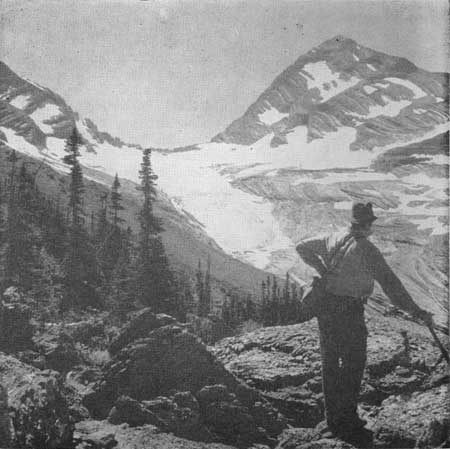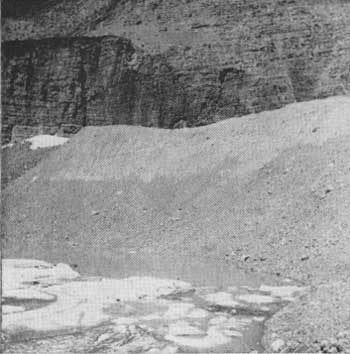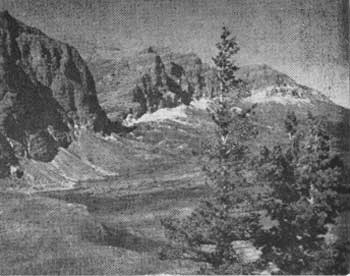
|
GLACIER
The Geologic Story of Glacier National Park Special Bulletin No. 3 |

|
THE LAST CHAPTER
Although events of the last 9,000 or so years didn't create the large spectacular features of the landscape, this period is nonetheless interesting because it witnessed the birth of all existing park glaciers and the return of the trees composing the present-day forests. As soon as the glaciers began to shrink trees undoubtedly started to reclothe the newly exposed surfaces. New varieties came from areas which had not been glaciated. From the Pacific coast came grand fir, Douglas-fir, larch, hemlock, white pine and others. From the east came another group including aspen, paper birch, hawthorn and maple. The native trees driven out by the ice also returned to again become important elements of the flora. These are Engelmann spruce, alpine fir, and lodgepole pine. A few species, among which are the alpine willows, driven southward from the far north during the Pleistocene period still persist at high altitudes but they are always ready to move down into the valleys if the climate should again become cool. Of course, continued warming would cause them to disappear. After the large Pleistocene streams of ice disappeared there followed a period of about 5,000 years during which the climate was somewhat warmer and drier than at present, conditions under which even very small glaciers could not have survived. Then about 4,000 years ago the advent of the cooler climate brought about the origin of the present glaciers. During the period of their existence they have fluctuated in size, probably attaining maximum dimensions around the middle of the last century. Since then they have been steadily shrinking, a sure indication that the climate is becoming milder, as it has so many times in the past.

|
| MOUNT JACKSON, VISIBLE FROM GOING-TO-THE-SUN HIGHWAY, IS COMPOSED OF STEEPLY TILTED STRATA OF THE SIYEH FORMATION. JACKSON GLACIER TO THE LEFT OF THE MOUNTAIN LIES ON THE SURFACES OF SEVERAL OF THESE STRATA. (DYSON PHOTO) |
Surrounding all these small glaciers are recent moraines composed of rock debris eroded from the basins in which glaciers lie. These moraines thus represent the amount of material removed, and then deposited, within the last 4,000 years. They are particularly striking at Grinnell and Sperry Glaciers and at the site of the former Clements Glacier near Logan Pass.

|
| MORAINE NEAR GRINNELL GLACIER IS 120 FEET HIGH. (DYSON PHOTO) |
Following disappearance of the large Pleistocene glaciers streams returned to the valleys and began to cut new valleys within the old. Because post-Pleistocene time has been of such short duration these new valleys are small youthful gorges. Interesting examples are Sunrift Gorge, where Baring Creek has cut a narrow channel into the upper part of the Appekunny formation; and the gorge at Hidden Falls on Hidden Creek in the Grinnell Valley. Sunrift Gorge lies only a few feet north of Going-to-the-Sun Highway at Baring Creek bridge, and Hidden Gorge is a stop on the guided trip which Ranger-Naturalists conduct from Many Glacier Hotel to Grinnell Lake. Both of these channels have very smooth, straight sides because they have been eroded along vertical fractures known as joints. The latter are common throughout the mountains and are responsible for the smooth surfaces on some of the highest cliffs. The gorge of Avalanche Creek near Avalanche Campground is another example of post-glacial stream erosion, only here the whirling action of sand and gravel-laden water has carved out a number of cylindrical potholes in the stream course. Some of them, though only 6 to 10 feet across, are 20 or more feet deep.
Since we know that the streams did not begin to cut these gorges until the large Pleistocene glaciers had disappeared from those sites, approximately 10,000 years have been required for their formation. Thus the average maximum rate of down-cutting has been of the magnitude of 0.002 to 0.003 inch per year. With these figures as a foundation it is not so difficult to comprehend that the much larger valleys of the park could not have been eroded in less than several millions of years.
Another common, though seldom noticed, post-glacial feature of the park is the alluvial fan. These are fan-shaped accumulations of gravel deposited by swift, tributary streams where they enter a main valley. Some of them have grown so large as to dam the stream in the major valley and cause a lake (Figure 2). St. Mary, Lower St. Mary, Lower Two Medicine, and Waterton Lakes are held in by such dams. The alluvial fan of Divide Creek which holds in St. Mary Lake can easily be distinguished from Going-to-the-Sun Highway on the north side of the lake near its outlet. The St. Mary Entrance Station is located on this fan. The lower lake is dammed by a large fan built into the St. Mary Valley by Swiftcurrent Creek. The straight section of highway between the town of Babb and the St. Mary River bridge lies on the lower part of this fan. Inasmuch as the Pleistocene glaciers undoubtedly removed any such fans made previously, those which are present today must have been constructed since disappearance of the ice, and are then not more than 12,000 years old. Most of them are somewhat older, possibly by as much as two or three thousand years, than the gorges mentioned above because the latter are located nearer the source of the glaciers, and their sites were thus still covered by ice after the falls had already begun to form. After the Pleistocene glaciers began their final retreat several thousand years elapsed before they disappeared from the mountains.

|
| FRONT OF LEWIS RANGE, NORTH SIDE OF SWIFTCURRENT VALLEY. THE LEWIS OVERTHRUST LIES AT THE BASE OF THE CLIFF. THREE LARGE TALUS CONES ARE VISIBLE BELOW MT. ALTYN ON THE LEFT. (DYSON PHOTO) |
One of the most conspicuous of all post-glacial features is the talus cone, an accumulation of angular rock fragments which fall from cliffs. It is only at the base of a crevice or chimney that this material takes the apparent form of a distinct cone. Elsewhere it is referred to as a talus slope or simply as talus, or, in the parlance of some mountaineers, as scree. Although several thousand years have been required for their formation most talus accumulations in the park are still actively growing, especially in spring and early summer when rocks are pried loose by the alternate freezing and thawing of moisture within fractures. The artillery-like crack made when a falling rock crashes to the base of a high cliff is a familiar sound to anyone who has spent much time in the mountains.
| <<< Previous | <<< Contents>>> | Next >>> |
gnha/3/sec7.htm
Last Updated: 11-Jul-2008